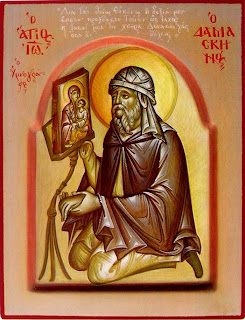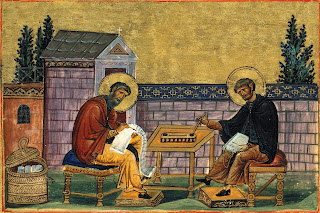Saint John of Damascus
(675-749), also known in the Orthodox Church as John the Damascene (Ἰωάννης ὁ
Δαμασκηνός) or Chrysorrhoas (Χρυσορρόας), “streaming with gold", or
"the golden speaker", or in Arabic as Yuḥannā Al Demashqi, is one of the most important
Christian writers of the first centuries, well known for his works in defending
the cult of the icons and in ecclesiastical hymnography. In the East he is
considered to be the last Father of the church. Consequently, the posterior ecclesiastical
writers are known as „post-patristic” Fathers of the Church.
Saint John was born in
an aristocratic family of Syria, but there isn’t clear if his parents were Arabs
or Greeks. There is clear that he spoke fluently the both languages. His grandfather,
Mansour, was an important person in Damascus, being responsible for the taxes
of the region under the Emperor Heraclius. He had also the difficult mission to
negotiate the capitulation of Damascus with the Arabs on September 4, 635.
There are different positions of the contemporaries about his attitude
concerning the Islamic conquest. There is sure that after this moment, Mansour
kept his important position, being one of the counselors of the Islamic Caliphs
Muawyya and Abd-el Maliq.
The counseling
position at the Arab court was very important in order to defend the Christians
in Syria. This position was inherited by Sergius (in Arabic, Sarjun Ibn
Mansur), the father of St. John, and the son of Mansour, as the chronicles
attest.


After a campaign in
Sicily, the Arabs came back with some captured persons, among which it was also
a scholar named Cosmas. Sergius redeemed him and made him the teacher of his
son, John. In the next years John excelled in music, astronomy, arithmetic and
geometry, but also in theology. Surely Cosmas, as a refugee from Italy, brought
with him also the scholarly traditions of Western Christianity, with whom St.
John is familiar, as there is to be seen in his dogmatic book „An Exact
Exposition of the Orthodox Faith”. In this time John studied together with an
adoptive brother, also called Cosmas, who later became a bishop in Maiouma, a
town in Syria (743).
There is not clear if
St. John inherited later his father’s position. The biographies state that he
did so, and after Caliph Omar II (717-720) started a harsh anti-Christian
campaign, John decided to renounce his position. Consequently he sold his
fortunes, gave them to the poor and retired into St. Sabbas (Mar Saba) Monastery
in the Jordan Valley, not far away from Jerusalem. The retirement of John from
this position should have let some traces in the official documents, which is
not the case. They only mention that his father Sergius left the administration
around around 706, when al-Walid I increased the islamicisation of the
Caliphat's administration, but fail to name John at all. His own writings never
refer to any experience in a Muslim court. Therefore there is possible that
John never held this position.

As monk at St. Sabbas
Lavra, John becomes shortly famous and Patriarch John V of Jerusalem ordains
him as a priest (735), giving him the mission to preach in the Church of
Anastasis in the Holy City. During this time the byzantine emperor Leo III
started a strong campaign against the public veneration of the icons (since
726), which is known as the iconoclastic period. St. John, far away from the
menace of the byzantine officials publishes manifests and books against the
emperor and his non-orthodox politics. The earliest work on this topic is the
"Apologetic Treatises against those Decrying the Holy Images", who
gave him a special reputation among the defenders of the icons. For the first
time he distinguishes between " worship” (latreia), which is proper only
to God, and "reverence" or „veneration” (douleia), rendered the
created things, including the saints, the icons and the holy relics. He attacks
in this work the emperor, adopting a simplified style of writing that allows
the controversy to be followed by the common people. A legend states that the
byzantine emperor planned revenge, by conceiving a false letter which
„accidentally” felt in the hands of the Islamic rulers. This later stated that
St. John worked together with the resistance, planning a byzantine re-conquest
of Syria. In this affair St. John would have been punished by cutting his right
hand. According to the legend, later John asked the rulers to give his cutted hand
back and miraculously the second day, after his prayers to the Mother of God,
he appeared publicly with the healed hand. As a special thank, he added a
silver hand (the third) to an icon of the Virgin in a church, this icon being
called further on as Theotokos Trigheirousa (with three hands). This pious
legend may be interpreted as a reason why St. John was so devoted to the cult
of the icon.


His position referring
the veneration of the icons and holy relics was later criticized at the
iconoclastic synod held in Hiereia, near Constantinople (754), where he was
together with Patriarch Germanos of Constantinople and George of Cyprus against
the anathemized. The iconoclastic emperor Constantine V named him as Ioannis
Mánzeros („bastard“, in Hebrew), a wordplay after the name of his grandfather, Mansur.
Anyway the later Synod
held in Nicaea in 787, also known as the 7th ecumenical council, used very much
of his argumentation. The council rehabilitated all the fighters for the icons
and, of course, among them, St. John who held his popularity and, probably, his
recognition as a saint of the Church.
The Works of St. John from Damascus
St. John wrote many
theological writings in which he defended the Orthodoxy against the iconoclasti
heresy but also against some earlier heresies as the monophisitism,
nestorianism, jacobism (spread among the syrians), manichaeism and even against
the sacred book of the Muslims. His
works are dogmatic, polemic, moral-ascetical, exegetical, oratorical and
poetical. Besides these, St. John composed many theological hymns, perfecting
the „canon”, a structured 9-ode hymn, used in Eastern Orthodox Church services
until today. Among the exceptional canons, there are to be mentioned the ones
for the Feasts of Christmas, Epiphany, Easter, Ascension, Pentecost,
Transfiguration and Dormition of Our Lady (practically, the most important
Feast in the Calendar). He is also the composer of the Octoechos (the Church's
service book of eight tones) one of the very important liturgical books used by
the choir during the all ritual services.
In defending the cult
of the icons he wrote „Three Apologetic Treatises against those denying the Holy
Images”. Another important work is the dogmatic „Fountain of Wisdom”, divided
into three parts: 1. „the Philosophical Chapters” - mostly dealing with the
logic), 2. „Concerning Heresy” (which refers in its last chapters to the
„heresy of the Ismaelites”), and 3. „An Exact Exposition of the Orthodox Faith”
or simply „The Dogmatic Book” (in western, better known as „De fide Orthodoxa”),
which is a concise a summary of the dogmatic writings of the Early Church
Fathers. This latter writing was the first work of Scholasticism written in the
Eastern Christianity and an important influence on later Scholastic works.


In a well/known homily
on the Annunciation, he calls the Holy Virgin as the Mother of the theological
virtue of the hope (spes, in Latin), the hope of the despaired, a formula taken
in the Catholic church in the prayer of Mary, Our Lady of the Sacred Heart, the
Hope of the despaired, but sometimes this formula is attributed to St. Ephrem,
another Syrian Father of the Church.
Another work, having a
controversial paternity, is „The life of the Saints Barlaam and Joasaph from
India”, which it may be a Christianization of Buddha’s biography.
After information from
his biographer, Stephanos Taumaturgos („The Healer”), St. John passed away on December
4, 749, being buried at the Monastery of St. Sabbas, near the shrine with the
relics of the founder of this old convent. His tomb and his cell became shortly
pilgrim points.
Veneration
Some pilgrims as the
Russian monk Daniel (1104-1006) and the Byzantine John Phokas (1185) wrote
about the tomb of St. John in the Monastery of St. Sabas. The relics might have
been transferred to Constantinople during the reign of the Emperor Andronicus
II Palaeologus (1282-1328). The absence of the relics from the St. Sabbas monastery
may be stated by another Russian pilgrim, the archimandrite Agrephenij, who
visited about in 1360/1370 the monastery and reports only about the cell of St.
John, saying nothing about his relics. A third pilgrim from Russia, Zosimas,
deacon at Holy Trinity Sergeyeva monastery indicates, during his rise
(1419/1421), the presence of a part of the relics at the monastery of the
Blessed Virgin Keharitomeni.
Some parts of the
relics of St. John are to be found today in the St. Georgios Alamanos Monastery
(near the village Pendakomo, Cyprus), in the monastery of St. John the
Theologian in Patmos (Greece) and the church of San Giorgio dei Greci ( Venice
).
Saint John of Damascus
holds a special veneration in the Eastern Church, which is quite old (maybe imediately
after the 7th ecumenical council from 787). He is venerated in the day of his
death, December 4 (or December 17, after the Gregorian calendar).
Pope
Leo XIII declared St. John of Damascus as « doctor ecclesia » in 1890
and inserted his name in the General Roman Calendar, on March 27. This date was
moved in 1969 to the day of the saint's death, so that he is now celebrated in
the same day both in the East and West.
The First Ode in the Canon of the Nativity,
written by St. John of Damascus
Christ is born,
glorify him. Christ is from heaven, go to meet him. Christ is an earth, be ye
lifted up. Sing to the Lord, all the earth. Sing out with gladness, all ye
people, for he is glorified!
Troparion (Hymn) of the Saint
Champion of Orthodoxy,
teacher of purity and of true worship, the enlightener of the universe and the
adornment of hierarchs: all-wise father John, your teachings have gleamed with
light upon all things. Intercede before Christ God to save our souls!


No comments:
Post a Comment